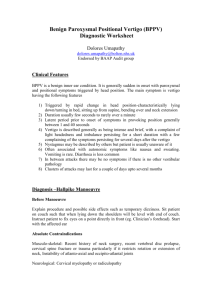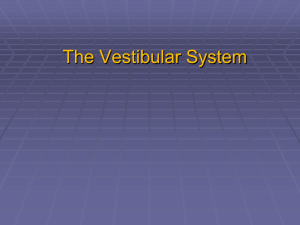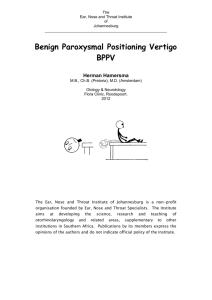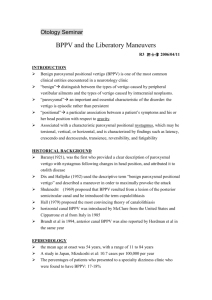Benign Paroxysmal Positional Vertigo
advertisement
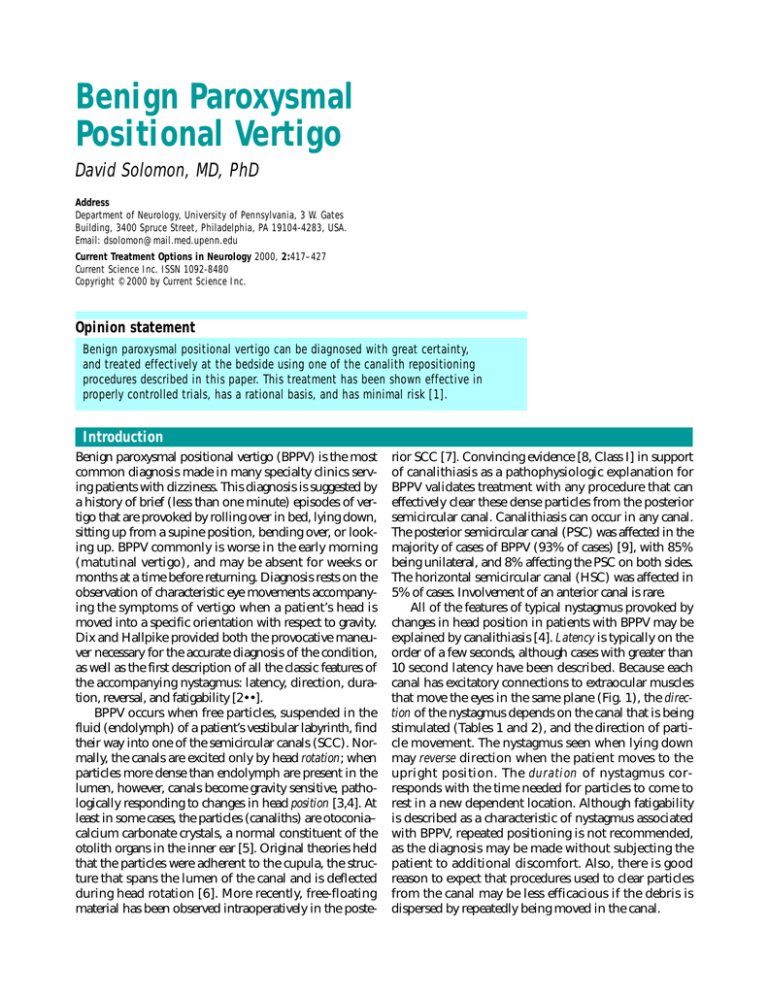
Benign Paroxysmal Positional Vertigo David Solomon, MD, PhD Address Department of Neurology, University of Pennsylvania, 3 W. Gates Building, 3400 Spruce Street, Philadelphia, PA 19104-4283, USA. Email: dsolomon@mail.med.upenn.edu Current Treatment Options in Neurology 2000, 2:417–427 Current Science Inc. ISSN 1092-8480 Copyright © 2000 by Current Science Inc. Opinion statement Benign paroxysmal positional vertigo can be diagnosed with great certainty, and treated effectively at the bedside using one of the canalith repositioning procedures described in this paper. This treatment has been shown effective in properly controlled trials, has a rational basis, and has minimal risk [1]. Introduction Benign paroxysmal positional vertigo (BPPV) is the most common diagnosis made in many specialty clinics serving patients with dizziness. This diagnosis is suggested by a history of brief (less than one minute) episodes of vertigo that are provoked by rolling over in bed, lying down, sitting up from a supine position, bending over, or looking up. BPPV commonly is worse in the early morning (matutinal vertigo), and may be absent for weeks or months at a time before returning. Diagnosis rests on the observation of characteristic eye movements accompanying the symptoms of vertigo when a patient’s head is moved into a specific orientation with respect to gravity. Dix and Hallpike provided both the provocative maneuver necessary for the accurate diagnosis of the condition, as well as the first description of all the classic features of the accompanying nystagmus: latency, direction, duration, reversal, and fatigability [2••]. BPPV occurs when free particles, suspended in the fluid (endolymph) of a patient’s vestibular labyrinth, find their way into one of the semicircular canals (SCC). Normally, the canals are excited only by head rotation; when particles more dense than endolymph are present in the lumen, however, canals become gravity sensitive, pathologically responding to changes in head position [3,4]. At least in some cases, the particles (canaliths) are otoconia– calcium carbonate crystals, a normal constituent of the otolith organs in the inner ear [5]. Original theories held that the particles were adherent to the cupula, the structure that spans the lumen of the canal and is deflected during head rotation [6]. More recently, free-floating material has been observed intraoperatively in the poste- rior SCC [7]. Convincing evidence [8, Class I] in support of canalithiasis as a pathophysiologic explanation for BPPV validates treatment with any procedure that can effectively clear these dense particles from the posterior semicircular canal. Canalithiasis can occur in any canal. The posterior semicircular canal (PSC) was affected in the majority of cases of BPPV (93% of cases) [9], with 85% being unilateral, and 8% affecting the PSC on both sides. The horizontal semicircular canal (HSC) was affected in 5% of cases. Involvement of an anterior canal is rare. All of the features of typical nystagmus provoked by changes in head position in patients with BPPV may be explained by canalithiasis [4]. Latency is typically on the order of a few seconds, although cases with greater than 10 second latency have been described. Because each canal has excitatory connections to extraocular muscles that move the eyes in the same plane (Fig. 1), the direction of the nystagmus depends on the canal that is being stimulated (Tables 1 and 2), and the direction of particle movement. The nystagmus seen when lying down may reverse direction when the patient moves to the upright position. The duration of nystagmus corresponds with the time needed for particles to come to rest in a new dependent location. Although fatigability is described as a characteristic of nystagmus associated with BPPV, repeated positioning is not recommended, as the diagnosis may be made without subjecting the patient to additional discomfort. Also, there is good reason to expect that procedures used to clear particles from the canal may be less efficacious if the debris is dispersed by repeatedly being moved in the canal. 418 Neurologic Ophthalmology and Otology Figure 1. In this view of vestibular and orbital anatomy from above, the dotted lines represent the planes containing the posterior semicircular canal (PSC) of the right labyrinth, the superior and inferior recti of the left eye, and the superior and inferior oblique muscles of the right eye. This corresponds to the main neuroanatomical connections of the vestibular ocular reflex. Activation of the PSC, therefore, results in a mixed vertical and torsional nystagmus, with the contralateral eye having more upbeat, and the ipsilateral eye more extorsional components. Table 1. Direction, latency, and duration of observed nystagmus Quick phase Slow phase Ipsilateral Contralateral Inferior oblique (extorsional) Superior oblique (intorsional) Superior rectus (upward) Inferior rectus (downward) Table 2. Positional tests for horizontal canal BPPV Head postion Nystagmus direction Affected side Mechanism Right ear down Geotropic (R beat) Stronger nystagmus with affected ear down Canalithiasis Left ear down Right ear down Geotropic (L beat) Ageotriopic (L beat) Left ear down Ageotriopic (R beat) Stronger nystagmus with affected ear up Canalithiasis Cupuloithiasis Cupuloithiasis Benign Paroxysmal Positional Vertigo Solomon 419 Treatment • Predisposing factors of BPPV: • Circumstances in which the head is placed or maintained in an inverted orientation (eg, dental procedures, visits to the hairdresser). • Age. • Inactivity. • Trauma and vestibular neuritis. • Other ear disease; Meniere’s syndrome [10]. • Family history [11]. Pharmacologic treatment Antiemetic therapy Promethazine Standard dosage Promethazine is administered orally at 12.5 mg, 25 mg, or 50 mg prior to treatment, or as a suppository at the same doses, if the patient is already symptomatic with vomiting. May be repeated every 4 to 6 hours. Contraindications Should not be used in those patients with adverse reactions to phenothiazines. Use with caution in those patients with narrow-angle glaucoma, and obstructive bladder disease. Main drug interactions May increase sedative action of other central nervous system depressants (alcohol, narcotics, and so forth). Main side effects Sedation, and dry mouth. Rarely, extrapyramidal motor manifestations (oculogyric crisis, dystonic reaction) occur. Special points Vestibular suppressants do not affect the vertigo associated with this condition [12]. At most, they may reduce the motion sickness, which frequently accompanies the attacks. Patients are routinely requested to stop symptomatic therapy prior to electronystagmogram (ENG) testing or examination, because a gaze evoked nystagmus, or pursuit abnormalities, may be caused by some vestibular suppressants. In general, there are no indications for the chronic use of vestibular suppressants such as meclizine. These may be used on an as needed basis to treat the motion sickness symptoms associated with attacks of labyrinthine vertigo, but habitual use will retard the process of central nervous system compensation following any change in peripheral vestibular function. Cost/cost effectiveness Only few doses should be required, and this medication is available in an inexpensive, generic form. Interventional procedures • Use of a canalith repositioning procedures (CRPs), such as the Epley and Semont maneuvers, depends on the accurate localization of particles. Examining physicians must determine the ear that is affected, which canal in the identified ear is affected, and whether the material is free-floating or adherent to the cupula. Dix-Hallpike test for posterior semicircular canal BPPV Diagnosis of BPPV affecting the PSC is made by observing the typical upbeat and torsional nystagmus (Table 1, Fig. 1) after performing the Dix-Hallpike maneuver. This is shown in the first two panels of Figure 2. The patient is seated with legs extended on the examining table, and the head is turned 45° to either the left or right. The patient is then brought into the supine position briskly, but this need not be done too rapidly. After observing for eye movements and questioning the 420 Neurologic Ophthalmology and Otology patient about symptoms, the patient is brought back to the sitting position. The head should be maintained in the same orientation with respect to the body during the entire maneuver. The fellow ear is then tested by rotating the head in the other direction and repeating the positioning. The patient must be brought upright between each ear test. Ideally, fixation is removed by monitoring eye movements using either an infrared camera system in darkness, or by using Frenzel lenses. Electro-oculography is insensitive to torsional eye movements, and two-dimensional video-oculography likewise may give spurious results. Even without removal of fixation, the torsional component of the nystagmus is not suppressed, and should remain observable. In making the diagnosis of BPPV, direct observation is therefore more helpful than laboratory testing. An upbeat-torsional nystagmus will be generated by the vestibular ocular reflex (VOR) as the patient is being moved, and the patient will correctly perceive head rotation. When the head comes to rest in its new orientation, normally, there is no further nystagmus or sense of movement. In the patient with canalithiasis (particles in the duct of the SSC), a second excitation occurs as the debris ‘gravitates’ to a new lowest point. This induces a response by the canal indistinguishable from that caused by actual rotation of the head in space—there is the same nystagmus and associated perception of rotation, now termed vertigo, which persists for as long as the particles are in motion. Because the quick phases of nystagmus are noted clinically, the actions of the superior rectus and inferior oblique account for the up beating and torsional directions, respectively (Table 1). The eye ipsilateral to the affected (down) ear has the more pronounced extorsional nystagmus, with the upper pole of the eye beating toward the ground. The contralateral eye is more upbeating. Note the direction, latency, and duration of the observed nystagmus. If horizontal nystagmus is seen in the Dix-Hallpike, then positional testing for horizontal canal BPPV should be performed (supine with head turns, discussed below). The nystagmus should appear more strongly. Frequently patients with BPPV have a spontaneous recovery, and the clinician may choose to observe only. Otoliths will dissolve in endolymph [13], likely accounting for some spontaneous remissions. Paroxysmal positional nystagmus has been reported in those patients with posterior fossa lesions. One can be certain of a peripheral etiology only when the following conditions are true: the nystagmus is in the plane of a single SSC, and the nystagmus is maximally generated when the gravity vector is moved in the plane of that canal [14••]. The Epley maneuver Standard procedure Using movements of the head and body (Fig. 2), which may be made gently, the affected posterior SCC is rotated with respect to gravity such that canaliths are moved out of the canal and into the vestibule, where they do not cause symptoms [15]. Contraindications Severe neck disease, high-grade carotid stenosis, and unstable heart disease. Oscillation is not used when perilymph fistula is suspected or there is a history of retinal detachment. Complications When moving material out of the posterior canal, there is a chance that it will relocate into another canal (on the same side). The most frequently encountered conversion will be from posterior to horizontal semicircular canal. This is more likely to occur if the head is not maintained in the proper position when the patient is brought upright (Fig. 2, F and G). The head on body orientation should remain constant, turned 90° away from the affected ear. If particles do enter the horizontal canal, it may be treated using the appropriate maneuver described below. If post-treatment instructions are used, no treatment may be required [16]. Main side effects Patients may become nauseated and vomit after Dix-Hallpike maneuvers, and may not tolerate a CRP. In these instances, there is no reason not to have the patient take an antiemetic prior to treatment. Benign Paroxysmal Positional Vertigo Solomon 421 Figure 2. The Epley maneuver. A, Turn the head 45 degrees toward the affected ear. B, Deliberately move the patient into the supine position, maintaining the head turn. Extend the neck just enough so that the downward ear is below the shoulder. C, Keeping the neck extended, rotate the head 90 degrees so that the unaffected ear is now pointed 45 degrees downward. D and E, The patient rolls into the right lateral decubitus position, and the head is rotated so the nose is now pointed toward the ground. Observe for nystagmus. Nystagmus with a downbeat component indicates an ineffective procedure. F, The patient brings the knees to the chest and drops the legs over the edge of the table, while the head is kept in the nose down position. G, The patient is brought up to the sitting position, keeping the head rotated close to 90 degrees on the body. In the upright position, keeping the chin tucked down, the head is rotated straight ahead, and then the patient may assume a normal head position (not shown). 422 Neurologic Ophthalmology and Otology Figure 3. Treatment for BPPV emanating from the left posterior semicircular canal begins with the patient sitting on the edge of the table (the same sequence would be performed for involvement of the right side, except that right and left would be reversed). A, The head is turned 45 degrees away from the affected side. B, The patient is then brought into the sidelying position, with the occiput resting against the surface and the affected ear downward. This position is maintained for at least one minute. C, The next change in position must be performed briskly; while keeping the head in the same orientation with respect to the body, the patient is rapidly moved through the original upright position to the opposite side-lying position. The patient is kept in this position, with the forehead against the surface, for another minute before being brought back to the upright position with the head still turned on the body. Note that throughout this maneuver, the head remains turned toward the same shoulder. Special points Factors for success include use of infrared (IR) video goggles for monitoring exactly what is going on throughout the maneuvers; repetition of the maneuvers at the same visit until nystagmus is cleared; timing of the maneuvers relative to the induced nystagmus; and judicious use of oscillation (discussed below). Bilateral BPPV is treated sequentially; therefore, a CRP is performed for the more symptomatic side, and on a return visit, if the treated side has resolved, the fellow ear may be treated. Cost/cost effectiveness Treatment is free, in that this maneuver may be included as a part of the clinician’s routine examination of the patient. Diagnosis and treatment of this condition may both be performed at bedside during an initial visit, without the use of blood or radiographic studies [17]. Many authors recommend the use of an IR video system for monitoring eye movements during positioning, but this equipment is by no means necessary for accurate diagnosis and successful treatment in the vast majority of cases, making this type of treatment highly cost effective. Liberatory (Semont) maneuver Standard procedure This maneuver was originally designed with the intent to dislodge particles stuck to the cupula, however, it is effective in treating PSC BPPV due to canalithiasis [18]. It must be performed rapidly (Fig. 3), and patients must be able to be moved quickly from one side-lying position to the other. It has been found to be equally effective as the Epley maneuver [19, Class II]. Contraindications This maneuver requires a brisk movement of the patient, and any orthopedic condition that limits patient mobility may be a relative contraindication. Benign Paroxysmal Positional Vertigo Solomon 423 Complications When moving material out of the posterior canal, there is a chance that it will relocate into another canal (on the same side). The most frequently encountered conversion will be from posterior to horizontal semicircular canal. This is more likely to occur if the head is not maintained in the proper position when the patient is brought upright (Fig. 2, from F to G). The head on body orientation should remain constant, turned 90° away from the affected ear. If particles do enter the horizontal canal, it may be treated using the appropriate maneuver described below. If post-treatment instructions are used, no treatment may be required [16]. Special points Factors for success include use of IR video goggles for monitoring exactly what is going on throughout the maneuvers; repetition of the maneuvers at the same visit until nystagmus is cleared; timing of the maneuvers relative to the induced nystagmus; and judicious use of oscillation (discussed below). Bilateral BPPV is treated sequentially; therefore, a CRP is performed for the more symptomatic side, and on a return visit, if the treated side has resolved the fellow ear may be treated. Cost/cost effectiveness Treatment is free, in that this maneuver may be included as a part of the clinician’s routine examination of the patient. Diagnosis and treatment of this condition may both be performed at bedside during an initial visit, without the use of blood or radiographic studies [17]. Many authors recommend the use of an IR video system for monitoring eye movements during positioning, but this equipment is by no means necessary for accurate diagnosis and successful treatment in the vast majority of cases, making this type of treatment highly cost effective. Positional test for horizontal canal BPPV The diagnostic maneuver used to elicit BPPV emanating from a horizontal canal is the same used to look for positional nystagmus: the supine patient’s head is rotated first to one side, then the other, and the eyes observed for evidence of a horizontal nystagmus. If significant horizontal nystagmus occurs without the subjective experience of vertigo, a central cause of positional nystagmus should be suspected. The direction of nystagmus will either be geotropic (fast phases toward the ground) or ageotropic (beating toward the upper ear), regardless of the position the patient is in [19]. (A horizontal positional nystagmus that does not change direction when the other ear is downward is not caused by BPPV.) Contrary to PSC BPPV, when the horizontal canal is affected there may be no latency, responses do not fatigue and the duration may be greater than 60 seconds [21]. The nystagmus often changes direction after a brief nystagmus-free interval, if the head is maintained in the testing position. If this occurs, the direction of the initial nystagmus should be used to determine the mechanism and affected ear. When horizontal canal BPPV is due to canalithiasis, the nystagmus is geotropic, and stronger when the affected ear is down (Table 2), because debris in the right horizontal canal moves toward the cupula when the head is turned to the right, the same way endolymph moves (relative to the cupula) when the head turns to the right—in the excitatory direction (nystagmus beats in the direction of head rotation, so the nystagmus in this example is right-beating, or geotropic). If the patient is then moved into the left-ear-down position, the debris in the right HSC moves away from the cupula, which is in the inhibitory direction for that canal. Thus the nystagmus beats to the left with the left ear down, but less strongly, because excitation can drive the vestibular ocular reflex better than inhibition (Ewald’s second law). Cupulolithiasis, in which debris is adherent to the cupula of the HSC, has been convincingly, though empirically demonstrated [21]. In this case, rotating the head toward the affected side will cause gravity to deflect the cupula toward the canal, which is inhibitory, thereby resulting in nystagmus beating away from the dependent ear (ageotropic). When the affected ear is upward, the cupula is deflected in the excitatory direction, and therefore a stronger (still ageotropic) nystagmus is observed. Standard procedure The treatment for HSC BPPV is a maneuver in which the head is first pitched chin down to bring the plane of the HSC perpendicular to the earth, while the patient is supine. The head and body are then rotated together toward the unaffected side. 424 Neurologic Ophthalmology and Otology Contraindications Complications Special points Cost/cost effectiveness Post-treatment instruction Continue the roll in the same direction through the prone position back to supine. When completing this “barrel roll” away from the target ear, keeping the chin down will help prevent movement of particles into the PSC. None reported. Nausea, vomiting, and vertigo during the procedure. Factors for success include use of IR video goggles for monitoring exactly what is going on throughout the maneuvers; repetition of the maneuvers at the same visit until nystagmus is cleared; timing of the maneuvers relative to the induced nystagmus; and judicious use of oscillation (discussed below). Bilateral BPPV is treated sequentially; therefore, a CRP is performed for the more symptomatic side, and on a return visit, if the treated side has resolved the fellow ear may be treated. Treatment is free, in that this maneuver may be included as a part of the clinician’s routine examination of the patient. Diagnosis and treatment of this condition may both be performed at bedside during an initial visit, without the use of blood or radiographic studies [16]. Many authors recommend the use of an IR video system for monitoring eye movements during positioning, but this equipment is by no means necessary for accurate diagnosis and successful treatment in the vast majority of cases, making this type of treatment highly cost effective. In the original descriptions of both the liberatory and repositioning procedures, patients were instructed to maintain an upright posture for 24 to 48 hours, so that their heads never tilted more than 45° from the vertical. This would entail sleeping in a recliner chair, and avoiding any bending over or looking upward. Some providers have patients wear a soft cervical collar after treatment to help patients comply with these instructions. The patients are then encouraged to sleep with the affected ear upward for several nights before returning to their normal routine. There is a theoretical rationale for these recommendations, namely to keep the offending particles from re-entering the canal from which they were removed. However, in one study designed to test the necessity of post-treatment instructions, there was no significant difference in success (no nystagmus on Dix-Hallpike one week after treatment) following either the Semont or Epley maneuver, with or without instructions. The overall success rate for all groups was 93% [19, Class I]. Surgery Semicircular canal occlusion and singular neurectomy These procedures are rarely required, and are reserved for treatment-resistant cases. Singular neurectomy, in which the branch of the VIIIth nerve to the PSC is selectively sectioned, is difficult and not widely performed. Plugging of the PSC is an effective method of treating refractory BPPV [22]. Hearing loss is a risk with any surgical approach to the labyrinth, and has transiently occurred after canal occlusion. Assistive devices Oscillators Several authors have reported the use of oscillation over the mastoid bone during the CRP, employing a hand-held massager. One study [23] concluded that mastoid oscillation was critical for success, however, only a single maneuver was performed prior to determining the outcome. Other studies [24, Class III] demonstrate excellent (94% success rate) treatments for PSC BPPV without the use of oscillation, and in a direct comparison no additional benefit was found [25]. Benign Paroxysmal Positional Vertigo Solomon 425 Figure 4. Brandt-Daroff exercises begin by sitting the patient upright on the edge of the bed, with the head turned 45 degrees to one side. The patient is instructed to move rapidly down into the side-lying position, keeping the head turned in the same direction. This position is maintained until the precipitated vertigo subsides, or at least for 30 seconds. The patient then returns to the upright, and holds this position for an additional 30 seconds. The head is then turned in the opposite direction, and the same procedure is repeated on the other side. Patients repeat the whole sequence until vertigo is no longer experienced with changes in position. These exercises may be performed several times each day, and should continue until at least one full day after no symptoms of vertigo are experienced. Rotator devices Various mechanical devices to perform particle repositioning, including a chair capable of rotating patients upside down have been successfully used [8,26]. No author suggests that such a device is required for treatment, however, they may be useful in patients who are difficult to maneuver due to mobility problems in the cervical spine, and simultaneous treatment of bilateral PSC BPPV may be accomplished with a 360° heels over head rotation. Physical therapy and exercise Brandt-Daroff exercises These exercises (Fig. 4) are reserved for patients who either fail or cannot tolerate either of the canalith repositioning procedures mentioned above [27], and may be used for any affected canal. They may be performed safely at home, and do not require a skilled practitioner. For patients with recurrent BPPV, we treat with a CRP, and then have patients perform Brandt-Daroff exercises daily, each morning, for prophylaxis against further episodes. These exercises are also useful in habituating the phobic responses, which commonly develop in patients with a predisposition for, or concurrent anxiety disorder. 426 Neurologic Ophthalmology and Otology Other considerations • Twenty percent of patients with BPPV have some other pathologic condition affecting the ear. BPPV alone cannot explain hearing loss, and BPPV is common in those patients with Meniere’s syndrome or following vestibular neuritis. • Nevertheless, resolving the positional component of an otherwise complicated clinical picture is helpful. Resolution of nystagmus following CRP may be taken as diagnostic of BPPV, and eliminate the need for further work-up if there are no other associated complaints or findings on examination. • BPPV may still be elicited from an ear with an absent caloric response, because the PSC is innervated by the inferior division of the vestibular nerve. The horizontal canal, which is stimulated by caloric testing, is supplied by the superior division. The vascular supply parallels this division as well. • Although some controversy lingers in the literature regarding the efficacy and rationale for treatment of BPPV with canalith repositioning [28•], the experience of most practitioners is that positive results are the rule, providing a gratifying experience for the provider and a grateful patient. References and Recommended Reading Papers of particular interest, published recently, have been highlighted as: • Of importance •• Of major importance Furman JM, Cass SP: Benign paroxysmal positional vertigo. N Engl J Med 1999, 341:1590–1596. 2.•• Lanska DJ, Remler B: Benign paroxysmal positioning vertigo: classic descriptions, origins of the provocative positioning technique, and conceptual developments. Neurology 1997, 48:1167–1177. A scholarly and informative paper on the history of BPPV and the emergence of the definitive therapy. 3. Hall SF, Ruby RR, McClure JA: The mechanics of benign paroxysmal vertigo. J Otolaryngol 1979, 8:151–158. 4. Epley JM. Positional vertigo related to semicircular canalithiasis. Otolaryngol Head Neck Surg 1995, 112:154–161. 5. Welling DB, Parnes LS, O'Brien B, et al.: Particulate matter in the posterior semicircular canal. Laryngoscope 1997, 107:90–94. 6. Schuknecht HF: Cupulolithiasis. Arch Otolaryngol 1969, 90:765–778. 7. Parnes LS, McClure JA: Free-floating endolymph particles: a new operative finding during posterior semicircular canal occlusion. Laryngoscope 1992, 102:988–992. 8. Lempert T, Wolsley C, Davies R, et al.: Three hundred sixty-degree rotation of the posterior semicircular canal for treatment of benign positional vertigo: a placebo-controlled trial. Neurology 1997, 49:729–733. 9. Honrubia V, Baloh RW, Harris MR, Jacobson KM: Paroxysmal positional vertigo syndrome. Am J Otol 1999, 20:465–470. 10. Hughes CA, Proctor L: Benign paroxysmal positional vertigo. Laryngoscope 1997, 107:607–613. 11. Gizzi M, Ayyagari S, Khattar V: The familial incidence of benign paroxysmal positional vertigo. Acta Otolaryngol 1998, 118:774–777. 1. McClure JA, Willett JM: Lorazepam and diazepam in the treatment of benign paroxysmal vertigo. J Otolaryngol 1980, 9:472–477. 13. Zucca G, Valli S, Valli P, et al.: Why do benign paroxysmal positional vertigo episodes recover spontaneously? J Vestib Res 1998, 8:325–329. 14.••Buttner U, Helmchen C, Brandt T: Diagnostic criteria for central versus peripheral positioning nystagmus and vertigo: a review. Acta Otolaryngol 1999, 119:1–5. This article describes central lesions that may masquerade as BPPV, and how to distinguish them on the basis of eye movements. 15. Epley JM: The canalith repositioning procedure: for treatment of benign paroxysmal positional vertigo. Otolaryngol Head Neck Surg 1992, 107:399–404. 16. McClure JA, Parnes LS: A cure for benign positional vertigo. Baillieres Clin Neurol 1994, 3:537–545. 17. Li JC, Li CJ, Epley J, Weinberg L: Cost-effective management of benign positional vertigo using canalith repositioning. Otolaryngol Head Neck Surg 2000, 122:334–339. 18. Semont A, Freyss G, Vitte E: Curing the BPPV with a liberatory maneuver. Adv Otorhinolaryngol 1988, 42:290–293. 19. Massoud EA, Ireland DJ: Post-treatment instructions in the nonsurgical management of benign paroxysmal positional vertigo. J Otolaryngol 1996, 25:121–125. 20. Nuti D, Vannucchi P, Pagnini P: Benign paroxysmal positional vertigo of the horizontal canal: a form of canalolithiasis with variable clinical features. J Vestib Res 1996, 6:173–184. 12. Benign Paroxysmal Positional Vertigo Solomon 21. 22. 23. 24. Steddin S, Ing D, Brandt T: Horizontal canal benign paroxysmal positioning vertigo (h-BPPV): transition of canalolithiasis to cupulolithiasis. Ann Neurol 1996, 40:918–922. Parnes LS, McClure JA: Posterior semicircular canal occlusion in the normal hearing ear. Otolaryngol Head Neck Surg 1991, 104:52–57. Li JC: Mastoid oscillation: a critical factor for success in canalith repositioning procedure. Otolaryngol Head Neck Surg 1995, 112:670–675. Wolf JS, Boyev KP, Manokey BJ, Mattox DE: Success of the modified Epley maneuver in treating benign paroxysmal positional vertigo. Laryngoscope 1999, 109:900–903. 427 Hain TC, Helminski JO, Reis IL, Uddin MK: Vibration does not improve results of the canalith repositioning procedure. Arch Otolaryngol Head Neck Surg 2000, 126:617–622. 26. Furman JM, Cass SP, Briggs BC: Treatment of benign positional vertigo using heels-over-head rotation. Ann Otol Rhinol Laryngol 1998, 107:1046–1053. 27. Brandt T, Steddin S, Daroff RB: Therapy for benign paroxysmal positioning vertigo, revisited. Neurology 1994, 44:796–800. 28.• Vrabec JT: Benign paroxysmal positional vertigo and otolith repositioning. Arch Otolaryngol Head Neck Surg 1998, 124:223–225. A concise, critical review of several studies establishing the effectiveness of particle repositioning procedures. 25.

